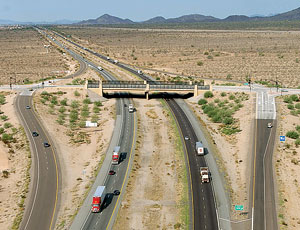Competition among bidders for stimulus funded projects such as Interstate 10 from Sarival Avenue to Verrado Way means that nearly one third of the $350 million in stimulus funds provided to the Arizona Dept. of Transportation has been reallocated in a second round of projects.


“The current economic conditions have created a trend toward lower-than-estimated bidding and a higher number of bids,” says ADOT Phoenix construction district engineer Robert Samour. With $114.5 million of savings from engineer’s estimates, Arizona transportation projects swelled from 41 to 59.
The six-mile I-10 widening, the state’s second-largest American Recovery and Reinvestment Act project, was estimated at $28.9 million. Of seven bidders, Tempe-based Fisher Sand & Gravel d/b/a Southwest Asphalt Paving bid lowest, at $21.8 million, more than $7 million below the engineer’s estimate.
“We are running pretty lean on this job,” says Southwest’s project manager, Kelly Schnepf. “Normally, I would have another engineer out here, but the dollars being what they are, we cut that out. We have to be really productive.”
Schnepf cuts overhead by splitting time as project manager on I-10 and another nearby job finishing up this year. The firm owns its own commercial asphalt plant.
Though I-10 was one of the first shovel-ready projects to be identified and bid, it was one of the last to begin construction due to a lengthy delay caused by a bid protest filed by the project’s second-lowest bidder, Phoenix-based Pulice Construction Inc., which accused Fisher of being non-responsive. The protest was eventually rejected as being untimely.
The 15-month project began in September, more than a month past the original start date, which may have costly impacts. “We are only allowed to place the asphaltic concrete friction course during certain periods, and that could have a pretty big effect,” Schnepf says. “Also with the concrete placement, if we end up pouring in the middle of summer, the costs are higher for chilling water and admixtures.”
The project will use 54,000 tons of asphaltic concrete and 205,500 sq yd of portland-cement concrete to renovate existing pavement, build an inside lane in each direction and add a new asphalt-paved shoulder. Six bridges will be widened and modified with concrete railings.
Schnepf says many drivers do not recognize the work-zone speed-limit reduction from 75 mph to 55 mph, and his biggest concern is safety.
The project will employ 50 to 60 workers at peak. Schepf says he probably will end up hiring 10 new people, and the job will sustain 15 to 20 more jobs at the firm. Subcontractors also will staff up for the project.


Post a comment to this article
Report Abusive Comment